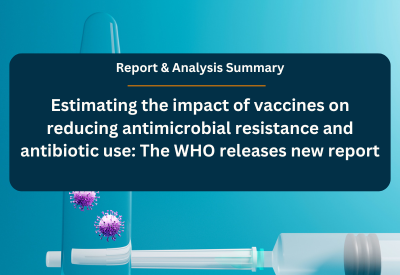Top
Long Reads | Opinion Piece | Healthcare Trends
8 Healthcare Trends Set to Shape the South African Healthcare Landscape
From genomics to wearables, the South African healthcare landscape is poised for a tsunami of changes in 2025. And that's before we get to the NHI. We've listed the healthcare trends and stories we'll be on the watch for next year.


Here's our list of healthcare trends and stories we think will shape the South African healthcare landscape next year.
1. The AI Revolution will become mainstream, even as legislators grapple to manage its impact
Artificial intelligence (AI) was the big tech story of 2024, and there is no doubt it will only get bigger in 2025.
While developing nations haven't seen the same explosive adoption as wealthier countries, AI is poised to revolutionise healthcare on the continent where it's needed most—improving care, tackling resource shortages, and easing overburdened systems.
We believe 2025 will be the year AI makes a real difference in diagnostics, reducing workloads, and sharpening therapeutic decisions.
AI-driven tools are already making a significant impact in early disease detection within the public sector. A prime example is the local deployment of computer-aided detection (CAD) systems for tuberculosis (TB).
These systems analyse digital X-rays with remarkable accuracy, enhancing diagnostic precision, enabling early intervention, and freeing up resources for direct patient care. Deployed in mobile X-ray vans stationed at community clinics or located in underserved communities, they ensure care reaches those who might otherwise go untreated. With TB remaining the world's leading infectious disease killer, this innovation represents a transformative step forward for the country's healthcare system.7
Radiology is also ripe for disruption. AI tools are increasingly able to automate tasks, enhance image analysis, and improve clinical decision-making. As with the TB system, CAD systems, for instance, are excellent at spotting abnormalities like tumours across CT, MRI, and PET scans. While these tools have mostly been limited to private healthcare, their potential for broader public health impact is undeniable.
Beyond diagnostics, AI is lightening the load for clinicians by automating admin, improving triage, and enabling real-time monitoring for faster interventions.
Chatbots like the GREAT4Diabetes initiative, currently active in the Western Cape, and the national implementation of MomConnect are all examples of how AI can boost health education and chronic disease management in the public health space. We anticipate that 2025 will see a proliferation of these applications.
"Lawmakers face the complex task of balancing the transformative benefits of AI in improving healthcare delivery and outcomes with these potential risks. Crafting regulations that both foster innovation and safeguard public interests is a delicate balancing act. Additionally, creating policies that encourage investment in AI technology while addressing the ethical and practical challenges it presents will be crucial."
In 2025, we anticipate significant developments in regulatory frameworks, with a growing focus on establishing international standards, increasing public awareness, and encouraging collaboration between governments, tech companies, and healthcare providers to create a safe and equitable environment for AI in healthcare.
2. Genomic Advancements: South Africa will continue its pioneering role
Breakthroughs in genomic technologies, such as CRISPR and gene therapy, are revolutionising global healthcare, enabling targeted treatments for various diseases, inherited disorders and cancers once deemed untreatable.
South Africa has emerged as a leader in genomics, boasting advanced sequencing platforms that are transforming healthcare and research across the continent. The Regional Centre of Excellence for Genomic Surveillance and Bioinformatics, established in 2021, has driven substantial progress in genomic surveillance, positioning South Africa as a regional hub for cutting-edge innovation.
"Between 2021 and 2022, genomic sequencing activities in Southern Africa quadrupled. Who could forget that South African laboratories were the first to detect the Omicron SARS-CoV-2 variant, underscoring the nation's capacity for rapid genomic response?"
Beyond infectious diseases, South Africa's genomic platforms have significantly impacted diagnostics for conditions like cystic fibrosis (CF).
However, challenges persist, including limited access to genetic testing in state healthcare facilities and the absence of a nationwide newborn screening programme.
One exciting program to watch out for in 2025 is the 110,000 Genomes Project.4
This is set to change with South Africa's proposed 110,000 Genomes Project, announced in November 2024 by the Department of Science and Innovation.4
The project will sequence the genomes of 100,000 randomly selected South Africans and 10,000 individuals with rare diseases. With fewer than 3% of global genomic research participants being of African descent, this initiative has the potential to significantly enhance health outcomes and place South Africa at the forefront of genomics research.
By identifying unique genetic variants and developing population-specific reference genomes, the project will enable personalised treatments for diseases which disproportionately affecting local populations. 2025 is expected to bring significant progress toward the realisation of this initiative.
These advancements come with legal and ethical challenges. While the Protection of Personal Information Act (POPIA) provides robust privacy protections, unresolved issues around data sovereignty, access, and benefit-sharing remain. Additionally, recent amendments to national health research guidelines that appear to permit heritable human genome editing have thrust South Africa into the centre of global ethical debates. We can expect to see a lot more action in this space in 2025.
3. Personalised Medicine coming to a clinic near you
Often considered the preserve of wealthier nations, alongside the genomics revolution, personalised medicine in Africa is poised to become a reality by 2025, transforming healthcare by tailoring treatments to individual genetic profiles.
The rise of pharmacogenomics, which studies how genetic variants affect drug metabolism and response, will help eliminate the guesswork currently involved in prescribing treatments.
Existing pharmacogenomic research has largely focused on European and Asian populations, much fo which may not be applicable to African genetic profiles – hence the importance of the 110,000 Genomes Project. Nonetheless, research on personalised medicine in South Africa is progressing rapidly, with studies on drugs for HIV, breast cancer, tuberculosis, and malaria already underway.
Genetic variants in populations of Botswana and Zimbabwe were also found to cause individuals to metabolise the drug differently, leading to toxicity. By adjusting doses based on genetic data, researchers were able to significantly improve treatment outcomes, where a shift to dolutegravir has enhanced patient compliance and viral control.
By 2025, the practical application of this research could make tailored treatment strategies more widely available.
Another promising area is the development of pharmacogenetics-guided treatment algorithms, such as the one being studied for hypertension in black South Africans. The research, which involves 600 patients from Soweto, aims to create guidelines for healthcare professionals to determine the most effective medications and dosages based on genetic factors, as well as other variables like age, body mass, and lifestyle.
As genomic sequencing becomes more affordable and accessible, the infrastructure to support personalised medicine in Africa is growing. However, challenges such as funding, education, and a deeper understanding of the African genome remain significant hurdles.
By unravelling the genetic diversity of African populations, personalised medicine in Africa could become more relevant and effective, improving treatments for diseases such as cancer, HIV, and others specific to African populations. The advancements have significant impacts not only on individual patients but also on our public health programmes, and we will be monitoring this space closely in 2025.
Back to top
4. Mental Health issues will remain a challenge for the country
Mental health remains a top priority on global healthcare agendas, and we expect continued focus on this issue here at home in 2025.
According to the second Annual Mental State of the World Report 2021 from Sapien Labs, South Africa ranks among the countries with the worst mental health outcomes. 6
Similarly, a recent white paper from the Wits/Medical Research Council's Developmental Pathways for Health Research Unit (DPHRU) revealed that 25.7% of South Africans are likely depressed, with over a quarter reporting moderate to severe symptoms. The prevalence of mental illness varies across provinces, with higher rates in the Northern Cape, Eastern Cape, Western Cape, Gauteng, and Mpumalanga.8
One significant barrier to people seeking help is the stigma surrounding mental health, particularly in black communities.
While workplace mental health initiatives and destigmatisation efforts are helping to expand access to care, digital apps and virtual therapy tools may have a significant impact in 2025.
The global mHealth market, expected to surpass $269 billion by 2032, is transforming mental healthcare delivery through mobile health solutions, which allow individuals to track health and manage well-being conveniently, especially as busy lifestyles and preferences for minimal in-person visits grow.
Emerging technologies, such as AI chatbots and virtual reality (VR) therapy sessions, are reshaping how mental health services are delivered. Patients have reported that virtual therapy, whether via an immersive VR or AR environment, helps create a sense of presence and engagement, even remotely.
The chatbots offer 24/7 support for those experiencing stress, anxiety, or depression, with studies showing a 64% greater reduction in depression symptoms for users compared to those who don't use these tools. On the clinician side, automated systems for risk assessment are also being developed, which will enable clinicians to focus more on direct patient care.
While these innovations hold great promise for tackling stigma, addressing resource shortages, and improving accessibility, the rapid growth of consumer apps offering therapeutic services has created a "Wild West" landscape in mental health technology. Calls for stricter regulation are growing, and as we look to 2025, ethical and legal challenges surrounding these technologies are expected to remain a key focus in the mental health space.
5. Health data will explode, and along with it, cybercrime.
The explosion of health data – from medical records to genomic information and wearable devices – is not only accelerating advances in healthcare science, it is exposing healthcare systems to exponential risks.
Cybersecurity challenges, such as data breaches, are estimated to cost the sector approximately $11 million per incident, highlighting the urgent need for robust data protection strategies in 2025.
One such local example was the June cyberattack on South Africa's National Health Laboratory Service (NHLS), which brought the system to a standstill, underscoring the vulnerabilities of critical healthcare infrastructure.
South Africa's healthcare sector has become a prime target for cybercriminals, with ransomware being the most serious and persistent threat.
"In 2024 alone, there were 224 reported ransomware attacks targeting healthcare globally, according to Check Point Software Technologies. The company notes that underreporting remains a challenge, making it difficult to assess the scale and impact of these attacks fully."
The introduction of South Africa's National Health Insurance (NHI) model is expected to heighten security risks due to the increased volume of data and expanded data targets.
As the healthcare sector transitions, the lack of adequate cybersecurity measures could leave it vulnerable to cyber threats.
Outdated technology, insufficient security protocols, and a shortage of specialised knowledge in critical institutions, including hospitals, compound this challenge. Ransomware attacks can delay treatments, compromise patient data, and result in significant financial and reputational costs.
Advanced security technologies, such as AI-driven threat detection, automated incident response, and threat intelligence platforms, are essential to combat these growing risks.
Without significant improvements in cybersecurity, healthcare providers face the potential for massive disruption, not just to operations but to patient trust and safety as well.
We anticipate that there will be more attacks such as that on the National Laboratory and urge our practitioners to skill up and improve their practice security moving forward into 2025.
6. The Future is Wearable
The health wearables market is poised for explosive growth in 2025, driven by technological advancements and increasing consumer adoption. Global trends suggest the market will grow from fitness-focused devices to include cutting-edge applications such as continuous glucose monitors, wearable ECGs, and biosensors capable of real-time health monitoring.
By 2030, the wearable technology industry is projected to reach $186 billion, highlighting its transformative potential in healthcare.
This capability is particularly beneficial in managing chronic conditions like diabetes and hypertension. However, adoption isn't without challenges: the accuracy of consumer-grade devices, battery limitations, and usability issues for older populations remain concerns. The future of wearables will hinge on addressing these pitfalls.
Enhanced data quality, interoperability across devices, and equitable access are crucial for sustained adoption. Integrating artificial intelligence with wearables promises to overcome data overload by identifying meaningful trends and supporting clinical decision-making.
Beyond individual care, wearables appear to offer the potential to reduce healthcare inequities. For instance, they could revolutionise maternal health, where 80% of morbidity cases are preventable, or facilitate broader participation in clinical trials among underserved populations.
With the big health insurers' Discovery, and more recently, Momentum Health driving the adoption of these technologies in an effort to reduce healthcare costs through the promotion of healthy lifestyles and early disease detection, there is no doubt that 2025 will see exponential growth in the adoption of wearables in South Africa.
7. Infectious diseases & AMR continue to occupy center stage, but it's Vaccines whose time has come
Infectious diseases will continue to dominate the headlines in 2025.
Over and above the Mpox and Marburg outbreaks in Africa, which for the moment seem to be under control, in the last quarter of 2024, we've seen an increase in cases of human infection with the H5N1 avian influenza virus - which saw the UK announcing it's intention to purchase 5 million doses of an H5 vaccine - and a global surge of cases of Measles in 2024. Undoubtedly we'll be hearing a lot more from these and outbreaks like them in 2025.
Accompanying the rise in the incidence of infectious disease has been an increase in research into viral diseases, including HIV and emerging viruses, which will remain a critical priority in 2025, especially in sub-Saharan Africa.
In 2024, significant progress was made in the HIV space, with lenacapavir—a novel twice-yearly injectable —being named Science's Breakthrough of the Year 2024 for its transformative potential in HIV management. In October, Gilead Sciences, the developer of lenacapavir, announced its intention to work with the South African government to expedite the local registration of this groundbreaking product.
South Africa's 95-81-91 treatment targets were met by the end of 2023: 95% of people with HIV knew their status, 81% of those with a positive status were on ART, and 91% achieved viral suppression. For 2025, these targets have been raised to 95-95-95. Whether this is achievable and whether it will help meet the UN Sustainable Development goal of a 90% reduction in new HIV infections by 2030 remains to be seen.
At the same time, the WHO released its report in October 2024, indicating that TB is once again the world's top infectious disease killer. We can expect to see increased activity in including coordinated, multisectoral action to tackle these broad issues and substantial investments in TB research, including vaccine development.
Antimicrobial resistance (AMR) will continue to be a grave concern, not only for sub-Saharan Africa but for the entire continent.Globally, drug-resistant infections currently claim around 700,000 lives annually, and this figure is projected to rise to 10 million by 2050 if left unchecked, with Africa potentially accounting for 4.5 million of those deaths.
"A report released by the Africa CDC in September 2024 warned that AMR is now a more significant threat to Africa than HIV-AIDS, tuberculosis, and malaria. Together, these three diseases now account for fewer deaths than AMR, which has a mortality rate of 27.3 deaths per 100,000 people, the highest in the world."1
The South African Antimicrobial Resistance National Strategy Framework, now in its second edition (2018-2024), continues to guide efforts to combat this issue.5
We predict an ongoing focus on the development of alternative treatments, including new antibiotics, to manage AMR and ensure effective treatment of infections.
In line with the World Health Organization's October report, which highlighted the importance of vaccines in preventing AMR and reducing mortality, vaccines targeting just 24 key pathogens could reduce global antibiotic use by 22%, equivalent to 2.5 billion defined daily doses annually—significantly contributing to AMR efforts.
Vaccine equity, however, will remain a contentious issue, and we expect much more debate around this topic in the year ahead.
Finally, the WHO's ongoing efforts to unite countries in pandemic preparedness strategies will continue.
Ensuring health systems in sub-Saharan Africa are better equipped to respond to future health crises and minimise their impact will remain a priority for public health officials.
8. Last but not least, the NHI: The Defining Healthcare story for 2025
There is no doubt that the National Health Insurance (NHI) will remain the biggest healthcare story of 2025.
Even as we write this, the Universal Healthcare Access Coalition (UHAC), representing the majority of South Africa's healthcare professional associations, has presented an alternative proposal to President Cyril Ramaphosa. You can read more on that story here.
Adding to the complexity, Business Unity South Africa's feedback on the NHI proposal—expected by Oct 30—remains pending. Meanwhile, the Democratic Alliance (DA) has hinted at plans to propose legislation allowing healthcare professionals to do community service and internships in private hospitals, further murking the waters.
These developments underscore the high stakes and divergent visions surrounding universal healthcare reform. With multiple stakeholders vying for influence, the NHI is poised to dominate public discourse in the coming year, shaping the future of equitable healthcare delivery in South Africa. The path forward will require collaboration, compromise, and a commitment to addressing the pressing needs of the country's healthcare system.
In Conclusion
The trends shaping 2025 reflect a dynamic interplay between technological innovation, global health needs, and patient-centric care. As we look to 2025, the convergence of these trends promises to reshape healthcare in South Africa, from the integration of AI and genomics into everyday practice to the ongoing fight against mental health stigma and antimicrobial resistance.
However, the real challenge will lie in ensuring that these innovations benefit all populations equitably and sustainably.
It will be an exciting year for healthcare in South Africa, and the sector's ability to adapt and evolve will determine its success in meeting the health needs of its people.
Back to top
References
1. Africa CDC. (n.d.). Antimicrobial resistance: New report warns of growing threat. Retrieved December 13, 2024, from https://africacdc.org/news-item/antimicrobial-resistance-new-report-warns-of-growing-threat/
2. du Toit, D. (2024, January 1). The future of medicine (Precision Medicine). University of the Witwatersrand. Retrieved from https://www.wits.ac.za/curiosity/stories/the-future-of-medicine.html
3. EAPASA. (n.d.). The state of mental health in South Africa. Retrieved December 13, 2024, from https://www.eapasa.co.za/the-state-of-mental-health-in-south-africa/
4. Front Line Genomics. (n.d.). World of genomics: South Africa. Retrieved December 13, 2024, from https://frontlinegenomics.com/world-of-genomics-south-africa/
5. National Department of Health. (n.d.). Antimicrobial resistance. Retrieved December 13, 2024, from https://knowledgehub.health.gov.za/content/antimicrobial-resistance
6. Sapien Laboratories. (n.d.). Mental state of the world report. Retrieved December 13, 2024, from https://mentalstateoftheworld.report
7. Spotlight. (2024, September 3). In the spotlight: Beyond the hype – What might AI actually mean for healthcare in SA? Spotlight. Retrieved December 13, 2024, from https://www.spotlightnsp.co.za/2024/09/03/inthespotlight-beyond-the-hype-what-might-ai-actually-mean-for-healthcare-in-sa/
8 Wits University. (2023, March). Depression, anxiety, and childhood trauma: Who’s most at risk? Wits University. Retrieved December 13, 2024, from https://www.wits.ac.za/news/latest-news/opinion/2023/2023-03/depression-anxiety-and-childhood-trauma-whos-most-at-risk.html
Back to topDisclaimer
This article is compiled from various resources researched and compiled by the contributor. It is in no way presented as an original work. Every effort has been made to correctly attribute quotes and content. Where possible all information has been independently verified. The Medical Education Network bears no responsibility for any inaccuracies which may occur from the use of third-party sources. If you have any queries regarding this article contact us
Fact-checking Policy
The Medical Education Network makes every effort to review and fact-check the articles used as source material in our summaries and original material. We have strict guidelines in relation to the publications we use as our source data, favouring peer-reviewed research wherever possible. Every effort is made to ensure that the information contained here is an accurate reflection of the original material. Should you find inaccuracies, out of date content or have any additional issues with our articles, please make use of the contact us form to notify us.









.png)



